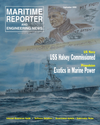
Page 28: of Maritime Reporter Magazine (September 2005)
Marine Propulsion Annual
Read this page in Pdf, Flash or Html5 edition of September 2005 Maritime Reporter Magazine
ter its economy and bad weather capabilities.
Ironically, while no longer in use on the Channel, hovercraft are enjoying a renaissance. Gas turbines have given way to more rugged and economical diesels and new materials and advanced designs mean that modern hovercraft are today the same price as they were 30 years ago. With its capability to operate in shallows, over coral reefs and on mudflats, with no ports and on unprepared beaches, hovercraft are com- ing in to their own in developing countries.
Crude but Effective
Before the advent of propellers in the 1830's, the pad- dle wheel was the standard form of mechanized ship's propulsion in all applications. Very much a technology of the steam age, paddle wheels were used in all forms of navigation - inland, coastal and seagoing.
With steam power dominant, the attraction of paddle wheels was the simplicity with which they turn the lin- ear motion of the steam engine into the rotary motion of the wheel. There were two configurations - the "side-wheeler" fitted with a pair of wheels on opposite side of the ships, and the "stern wheeler" which used a single paddle wheel mounted aft. The side-wheeler paid the penalty of a wider beam but was highly manoeuvrable, since propulsion could be applied on only one side of the ship. The first paddle steamer was the Pyroscaphe built by Frenchman Claude de
Jouffroy in 1783. But political events in France did not favor further development and the next attempt was by a Scottish engineer, William Symington.
Experimental boats built in 1788 and 1789 worked well, and in 1802 Symington built the successful barge-hauler, Charlotte Dundas. A great success story of the paddle wheel era were the stern-wheelers invent- ed by American Robert Fulton and which plied the great rivers of North America. Great romance attached to these combinations of transportation, floating hotels and gambling casinos.
However, the limited efficiency of paddle wheel propulsion became very clear in seagoing applications.
The first vessel to make a long ocean voyage was the
Savannah, built in 1819 expressly for transatlantic service. She made the first powered crossing of the
Atlantic but also carried a full rig of sail to assist the engines. The largest paddle-steamer ever built, the
Great Eastern, was designed by great Victorian engi- neer Isembard Kingdom Brunel.
In oceangoing service, the paddle steamer became obsolete with the invention of the screw propeller, but like many supersceded technologies it found useful niche markets. As well as being very manoeuvrable, side-wheel paddle steamers require only a shallow draught and are ideal for shallow rivers, coastal waters and tidal estuaries. For example, the Elbe river is only about two meters deep in its middle reaches, and the paddle steamer fleet in Dresden, Germany, is said to be the oldest and biggest in the world. 28 Maritime Reporter & Engineering News
Marine Propulsion
Crude but Effective
Hovercraft: Concorde of the Seas
For over 20 years the "stretched" version of the massive, SRN4 hovercraft carried up to 424 passengers and 54 cars between Dover and Calais. (Photo Credit: Rob Fuller)
Stern-wheelers have generally been used as riverboats, especially in the United States, where they still operate as tourist attractions, primarily on the Mississippi River. (Photo Credit: David Mesler for The New Orleans Steamboat Company)
The preceding was written by By Jan Rijder and reprinted, with permission, from PrimeMover mag- azine.
Silver Award for "PrimeMover"
PrimeMover Magazine published by MAN B&W
Diesel, designer of large-bore diesel engines, has been awarded the silver medal in the competition "Best of Corporate Publishing 2005" as one of the best customer magazines. "The award for 'PrimeMover' acknowledges our ambition to pro- vide our customers with information on the high- est level of journalism", said Andreas
Lampersbach, head of company communica- tions.
MR SEPTEMBER 2005 #4 (25-32).qxd 9/1/2005 11:52 AM Page 28

 27
27

 29
29
